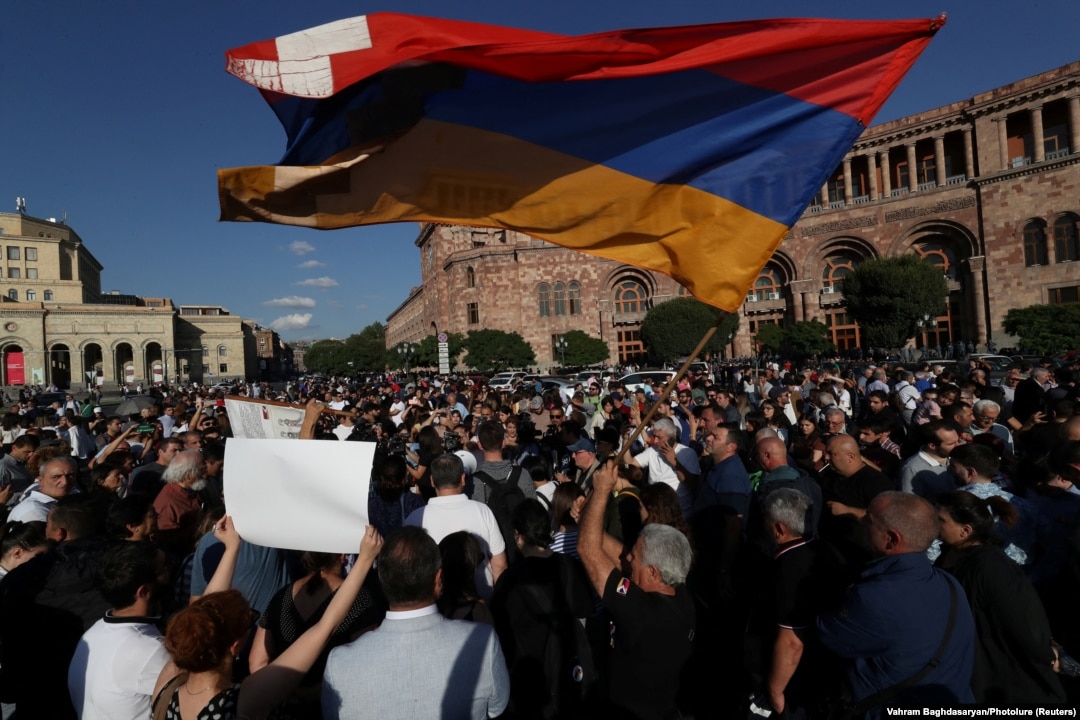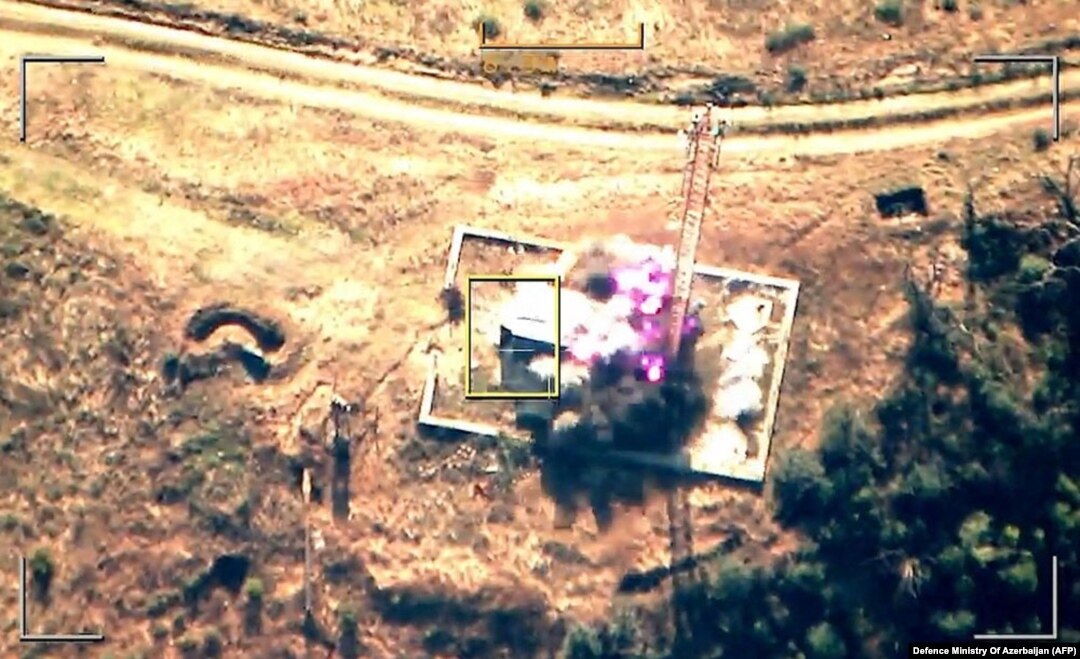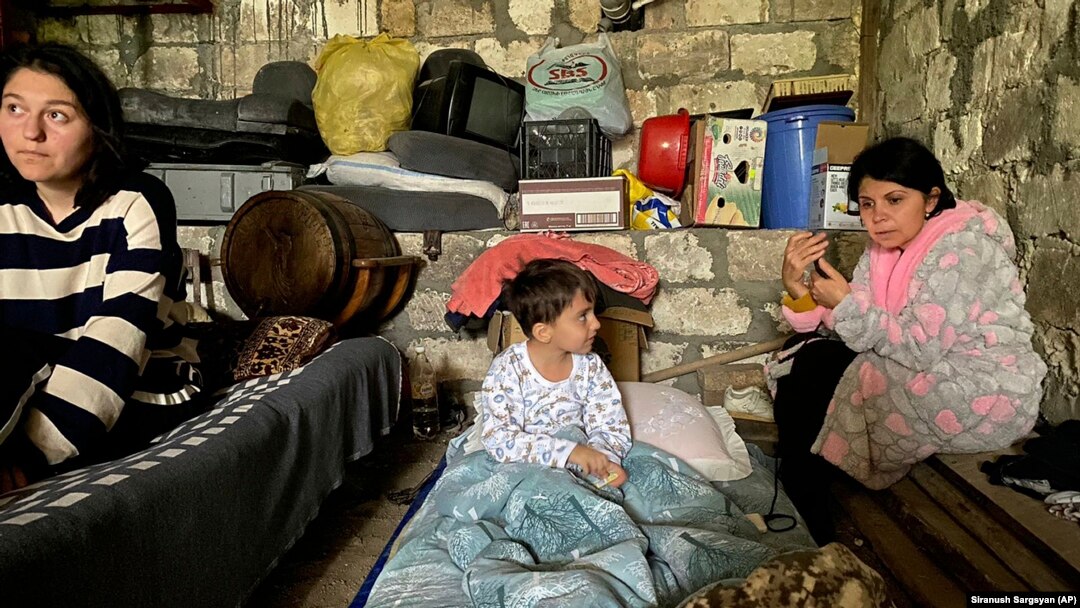Protests In Yerevan Follow Azerbaijani Attacks As Karabakh Residents Seek Shelter

Protesters gather near the government building in Yerevan on September 19.
The Azerbaijani and ethnic Armenian sides agreed on September 20 to an immediate cease-fire on the second day of a major flare-up in fighting over the territory of Nagorno-Karabakh, after the de facto leadership of the mostly ethnic Armenian enclave accepted a proposal by the Russian peacekeeping mission there and agreed to talks on the territory's "reintegration" into Azerbaijan.

Handout footage released by the Azerbaijani Defense Ministry on September 19 shows an explosion in mountainous terrain that Baku claims to be Azerbaijani forces "destroying positions" used by Armenians in the Nagorno-Karabakh region.

Children sit in a shelter during shelling in Stepanakert, the provincial capital of Azerbaijan's breakaway region of Nagorno-Karabakh, on September 20.
Azerbaijan declared that it had started what it called an "anti-terrorist operation" targeting Armenian military positions in Nagorno-Karabakh, where local ethnic Armenian officials reported heavy shelling.
Armenian Prime Minister Nikol Pashinian said, in a shot at Baku's justification for its offensive, that Yerevan "does not have an army" in Nagorno-Karabakh.
In an image released by the Russian Defense Ministry on September 20, Russian peacekeepers help evacuate refugees from Stepanakert.
TASS quoted the ministry as saying its peacekeepers had evacuated more than 2,000 civilians from Nagorno-Karabakh.
In a rare show of agreement with the West, Moscow called on both sides to stop the violence.
People huddle in a basement in Stepanakert on September 20.
Smoke rises over an area that Azerbaijan claims hosts ethnic Armenian forces' positions in the breakaway territory of Nagorno-Karabakh on September 19.
The expected halt in intense fighting in the decades-old Caucasus hot spot comes as international fears of a widening conflict mounted and as the death toll increased in the deadliest military escalation there in nearly three years.
Children sleep in a shelter during shelling in Stepanakert.
Azerbaijan’s Defense Ministry said on September 19 that "only legitimate military targets are being destroyed," and the Foreign Ministry said the only path to peace in the region was the complete withdrawal of Armenian forces from the territory.
Armenians protest in central Yerevan on September 19 to urge the government to respond to the Azerbaijani military operation.
After a brief but bloody six-week war between the regional archrivals in 2020, Azerbaijan recaptured much of Nagorno-Karabakh and seven surrounding districts controlled since the 1990s by ethnic Armenians with Yerevan's support.
A woman sits on a staircase in a residential building destroyed in a military strike on Stepanakert.
A residential apartment building was damaged by shelling in Stepanakert.
The Azerbaijani and the ethnic Armenian sides agreed to talks on September 21 in the Azerbaijani city of Yevlax, about 265 kilometers west of Baku.
People rally outside the Armenian government building to protest against Pashinian in Yerevan on September 19.
Pashinian, who was blamed by nationalists and other critics for losses in the 2020 fighting, noted the cease-fire but immediately distanced his government from its terms.
Protesters block a road near the government building in Yerevan on September 19.
Angered by what they saw as Moscow's failure to stop Azerbaijan, demonstrators also gathered outside the Russian Embassy in Yerevan, chanting anti-Russian slogans, TASS reported.
A woman embraces a child in a shelter during shelling in Stepanakert.
U.S. and European leaders had long called for Azerbaijan to ease the transit of humanitarian aid to the beleaguered region, which is experiencing shortages of food, energy, and medicine.
Angry crowds gathered outside government buildings in Yerevan late on September 19, calling for Pashinian to resign.
Armenians in Yerevan protest to urge the government to respond to the Azerbaijani military operation.
After weeks of bloody skirmishes and one day after an aid shipment was finally allowed into the area, Azerbaijan launched the major escalation on September 19 with the breakaway region already teetering on the brink of a humanitarian crisis after being essentially blockaded for more than eight months despite international calls for Baku to allow food and other shipments.
Damage is seen in a residential area after a military strike on Stepanakert.
The de facto human rights ombudsman in the ethnic Armenian-controlled Azerbaijani region said early on September 20 that 32 people had been killed, including seven civilians, two of them children, and more than 200 wounded as a result of shelling, although some death estimates put the death toll considerably higher.
Smoke rises from artillery strikes on a hilltop outside Stepanakert.
The UN Security Council scheduled an emergency meeting for September 21 as the international community sought ways to avoid an intensification of a long-running conflict that has already sparked two intense wars between the post-Soviet Caucasus neighbors.

